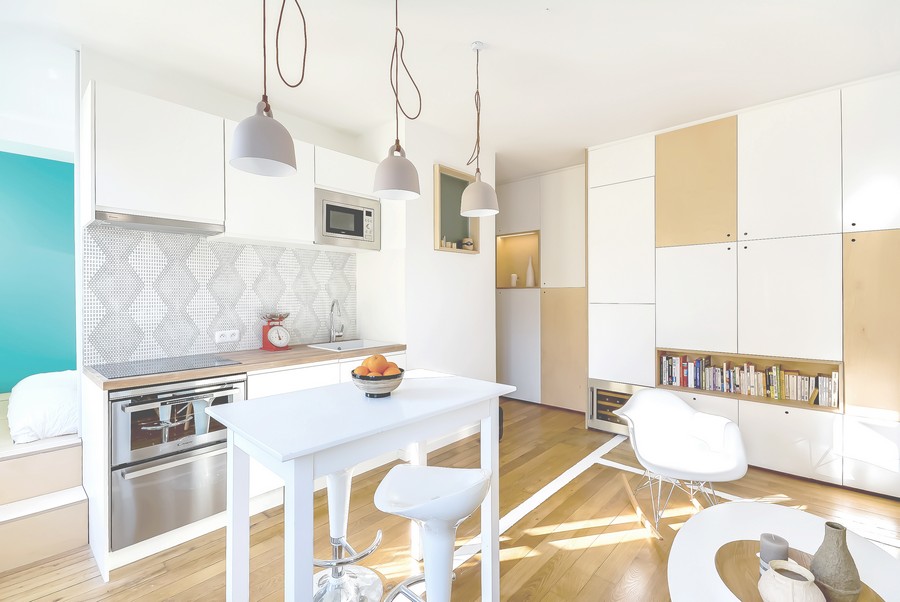Anyone living in London, or any other expensive city, knows you’re not going to find your ideal space for the most affordable price.
Properties are rising in value while spaces are shrinking, and rooms that you could hardly swing a cat in are becoming the norm.
With more city dwellers ‘micro-living’, it can play havoc when designing your home the way you would like.
But even though you may live in a box and have more ‘stuff’ than square metre, don’t despair.
It is possible to utilise all the space efficiently in a cramped home, without having a cluttered mess.
Here are some simple design tricks to buy you extra room.
Keep it in proportion
There’s nothing worse than furnishings that look out of proportion.
Like the perfect sofa (barely squeezing through the front door), taking over the entire room.
Or the 4ft-long coffee table that you keep knocking your legs on each time you walk around it.
Before you even start buying, check the right scale, measure up and think about how you want to make the most of your space.
If your room is too compact for a conventional dining table, try a round one.
And if the sofa doesn’t fit snug against the wall, go for a corner sofa to maximise space.
The same goes for ‘too small’ furniture that looks tiny in a large living space.
Mirror, mirror
Mirrors reflect light and are one of the best ways to instantly make your tiny space feel open and airy, especially if they are opposite a window.
But any reflective surface such as stainless steel in the kitchen, glossy surfaces and metallic accessories will also do the trick.
A full-length mirror in a narrow and dingy hallway always makes the space seem brighter.
Float on
Furniture doesn’t always have to be on the ground taking up valuable floor space.
Depending on how strong your walls are, floating shelves, cabinets and storage units can be hung up.
My favourites are the floating box shelves and cupboards that are practical storage but also look attractive.
Just don’t forget to check what’s behind the wall before you start drilling holes everywhere.
Look out for wires for example, and measure up properly as you don’t want to create an eyesore.
For renters, do first check in your agreement if it’s allowed or face the wrath of your landlord.
In the nooks and corners
If you have any alcoves or recesses in your walls, you can use those for shelves or any display items.
Built-in bookshelves give you extra storage space without having a chunky piece of furniture protruding into the room.
Corners can be such a waste if not used properly. Whether it be an L-shaped sofa, TV cabinet or shelf, these ‘corner’ designs can fit neatly into the room and save you space.
Out of sight
Multi-purpose storage such as ottomans or blanket boxes are clever ways of hiding clutter as well as being comfortable seating.
You can get various sizes and styles that compliment your rooms and they are a great way to store children’s toys and keep the mess at bay.
If you don’t have space for a cumbersome coffee table, a nest of tables or smaller side tables, can tuck in neatly in a corner or be easily moved around the home.
Keep it neutral for smaller rooms
One of the most popular small living room ideas is the use of neutral colours on walls, floor, ceiling and furniture upholstery.
Tones like off-white or beige expand the space and also tend to illuminate a room by reflecting the light.
You could always add splashes of bold colour throughout with your décor.
A large colourful rug, vibrant cushions, accessories or wall art can compliment neutral walls, so it doesn’t feel too clinical and bland.
Off the rails
Hanging things on wall-mounted rails can be handy. You’ll have more counter space and it looks less cluttered.
People tend to do this in compact kitchens or bathrooms where storage is limited but you can use rails anywhere in the home.
Racks on the back of doors to either hang clothing or accessories are also really good.
For the original article click here: https://metro.co.uk/2018/05/26/7-interior-design-tips-for-when-your-home-is-the-size-of-a-shoebox-7557831/


